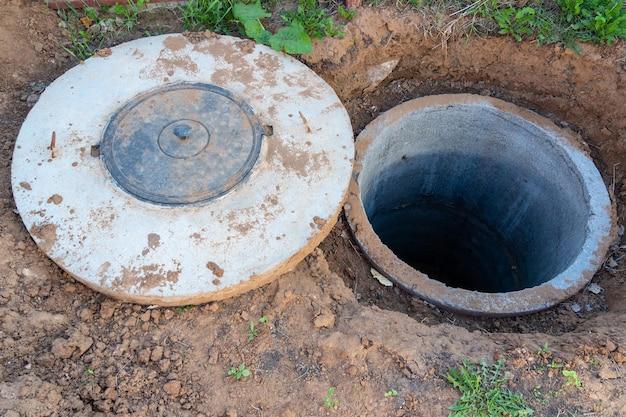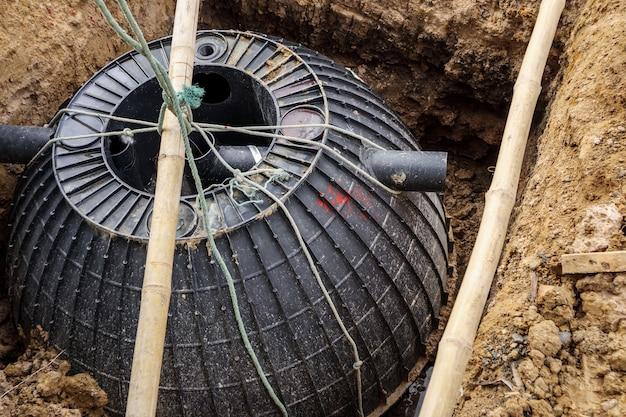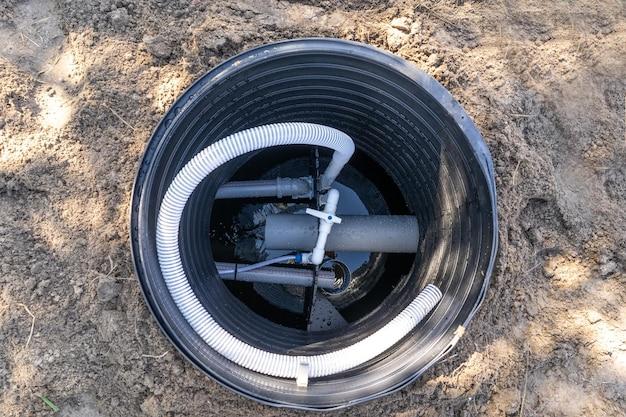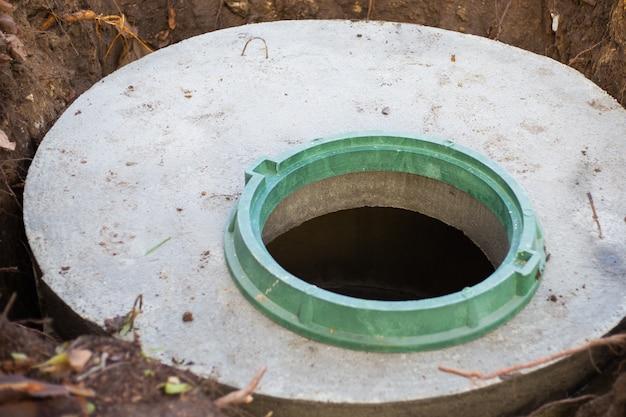If you’re experiencing issues with your septic system, you’re not alone. Many homeowners struggle with a septic tank that won’t drain properly, leading to a range of problems like slow draining sinks, unpleasant odors, and even sewage backups. In this comprehensive guide, we’ll explore common signs of septic system failure, what to do if your septic tank is not draining, and how to unclog a septic tank yourself. We’ll also discuss why your septic tank may be full again after just having it pumped, common causes of a clogged septic tank, and whether or not a septic tank full of water will not drain after rain. So if you’re tired of dealing with a stubborn septic tank, keep reading for everything you need to know.
Common Causes of Septic Tank Blockage
Septic tanks are a crucial component of any home or building’s sewage system. But, sometimes, they don’t work as they should. One common problem that many homeowners face is a septic tank that won’t drain. This issue often causes a backup of sewage, leading to unwanted odors and messy sewage spills. Here are some common causes of septic tank blockage:
Tank Overload
When too much of anything is put into a septic tank, it can’t function correctly, leading to blockages. Overloading can occur when too much water is used, or when substances such as grease, oil, or solid waste are disposed of in the system.
Septic Tank Design Flaw
Sometimes, a septic tank won’t drain due to a flaw in the tank’s design. When a septic system isn’t installed correctly, or it was built with incorrect materials, it can lead to severe problems.
Tree Root Invasion
Tree roots can penetrate septic tanks, causing blockages. Roots can cause cracks in the tank over time, allowing for sewage to leak out and debris to get in.
Clogged Pipes or Drain Field
If the pipes leading to or from the septic tank are clogged or the drain field is blocked, sewage won’t be able to drain correctly, leading to backups in the tank.
Whatever the cause, a septic tank that won’t drain can be a real headache. If you’re experiencing this issue, it’s essential to identify and fix the problem quickly to avoid any costly and messy damage.
Signs of Septic System Failure
Are you afraid that your septic tank won’t drain? It might be time to take a closer look at your septic system. Here are some signs that your septic system might not be performing at its best.
Slow Drains:
Do you notice that it takes longer for water to drain in your sink or shower? This could indicate that you have a clog somewhere in your plumbing, which could mean that your septic system is failing.
Foul Odors:
If you notice that there’s a bad smell coming from your plumbing, it’s time to take action. This could mean that your septic system is backed up, which can lead to serious damage to your home if not addressed quickly.
Lush Green Grass:
If you notice that your yard is looking greener and healthier than usual, this could be a sign that your septic system is failing. Your septic system could be overflowing and providing excessive nutrients to the grass, causing it to grow more than normal.
Backup in Drains:
If you notice that your plumbing is backing up or if you see sewage in your yard, it’s time to call a professional. This could mean that your septic system is clogged or failing, and it’s important to address the issue as soon as possible to prevent major damage to your home.
Slow Flushing Toilets:
If you notice that your toilet is slow to flush or if it seems to be stopped up frequently, it’s a sign that your septic system might not be working correctly. This could be due to a clog or a malfunctioning septic system, so it’s important to have it inspected as soon as possible.
By keeping an eye out for these signs, you can catch a septic system failure early on and avoid major issues later on. If you’re concerned about the health of your septic system, don’t hesitate to give a professional a call!
How to Unclog Your Septic Tank Yourself
Got a septic tank that won’t drain? Don’t worry; it’s not the end of the world. While it might be tempting to call a professional, there are some things you can try on your own before you resort to outside help.
Rule #1: Safety First
Before you dive into unclogging your septic tank yourself, remember to always put safety first. Septic tanks are filled with dangerous chemicals, and you don’t want to expose yourself to any harmful substances. Make sure you wear appropriate protective clothing, including gloves, goggles, and a mask, before you start. And if at any point you feel uncomfortable, stop and call in a professional.
Step 1: Locate the Problem
The first step in unclogging your septic tank is to find out where the problem lies. Check your drains and toilets to see if they’re clogged, slow, or backing up. If only one or two are affected, the problem may be localized to those pipes. If they’re all affected, however, the blockage is likely in your septic tank.
Step 2: Try Plunging
If you think your blockage is localized to a particular drain or toilet, try using a plunger. Fill the sink or toilet with about an inch of water and push the plunger up and down forcefully. Hopefully, this will dislodge any blockages and get things flowing again.
Step 3: Use a Drain Snake
If plunging doesn’t work, it’s time to bring out the big guns: the drain snake. A drain snake is a long, flexible cable that you can insert into your pipes to break up blockages. You can buy a drain snake at any hardware store, or you can rent one from a tool rental shop.
Step 4: Consider a Chemical Solution
If plunging and snaking don’t work, you may need to turn to chemical solutions. There are many different types of drain cleaners available in stores, but you need to be careful when using them. Most drain cleaners are made of harsh chemicals that can be dangerous if they come into contact with your skin or eyes. Plus, if used incorrectly, they can cause the pipes in your septic tank to corrode and leak.
If you’re dealing with a septic tank that won’t drain, the good news is that you don’t necessarily need to call in a professional. With a little bit of know-how and elbow grease, you can unclog your septic tank yourself. Just remember to put safety first, take things slow, and don’t be afraid to call in outside help if you need it.
What to Do If Your Septic Tank is Not Draining
So, you’re knee-deep in sewage and your septic tank isn’t draining. Relax, take a deep breath (but not too deep), and let’s solve this crap-tastic problem.
Check the Obvious
Before you call in the big guns (the plumbers), check for any obvious reasons why your septic isn’t draining. Is your toilet clogged? Did you flush something you shouldn’t have (we’re looking at you, non-flushable wipes)? Are your drains blocked? It might be gross, but it’s worth checking.
Pump It Up
If you’ve ruled out the obvious, it might be time to pump your septic tank. Septic tanks need to be pumped regularly to avoid blockages and ensure they work properly. If you can’t remember the last time you pumped your tank, it’s likely that’s your problem. Call in a professional and get your tank pumped ASAP.
Don’t Be a Drain Brain
Are you pouring cooking grease or oil down the drain? What about flushing feminine products or paper towels? Stop! These items are not meant to go down your drain or toilet and could be causing blockages. Be mindful of what you put down your drains to avoid future septic tank drama.
Check Your Drain Field
If your septic tank is working correctly but still not draining, it might be your drain field. A drain field is the area where wastewater from your septic tank is absorbed back into the ground. If it’s clogged or damaged, it could cause your septic tank to back up. Call in a professional to inspect and repair your drain field.
Don’t DIY
Sure, DIY projects can be fun, but septic tank problems are nothing to mess around with. It’s best to leave this dirty work to the professionals. Not only can they diagnose and fix your problem, but they can ensure that your septic tank and drain field are in good working order.
In conclusion, a septic tank that won’t drain is a crappy problem to have. Check for obvious reasons, pump your tank if necessary, be mindful of what you put down your drains, inspect your drain field, and leave the dirty work to the professionals. With a little patience (and a lot of bleach), you’ll be back to having a fully functioning septic system in no time.
Septic Tank Pumping: The Joy of a Full Tank
Ah, the joy of having your septic tank pumped; it’s the equivalent of hitting the flush button and watching everything disappear. It’s like starting with a clean slate, a fresh canvas, a new beginning. But wait, what’s this? Your tank is full again? How could this be?
The Dirty Truth
First things first, let’s clear something up. Your septic tank may be full, but it’s not full of good times and happy memories. Nope, it’s full of unpleasant substances that require a specific, disgusting type of removal. When you get your septic tank pumped, it’s important to remember that it’s not a cure-all for septic problems. It’s just a temporary fix that allows your system to function correctly. So, why is your tank full again?
Possible Causes
There are several reasons why your tank may be full again after getting it pumped. One common issue is that your tank may be undersized. If your family has grown, and you haven’t upgraded your tank size to accommodate the additional waste, you may find yourself dealing with a full tank more often than you would like. Another possibility is that you have a leak in your system. This leak could be from your tank, pipes, or drain field, and it’s letting water in faster than your system can handle. And lastly, it could also be due to improper use of your system. Yes, we’re talking about flushing things down the toilet that should never go down there.
Prevention is Key
Now that we know why your tank is full again, how can we prevent it from happening in the future? First, and most importantly, be mindful of what you’re flushing down your toilet. Only human waste and toilet paper should go down there; any other “flushable” items may cause clogs or other septic problems. Second, make sure you’re not overusing water in your household. You can do this by fixing leaks, using a low-flow toilet, and taking shorter showers. And lastly, if you’re frequently dealing with a full tank, it may be time to upgrade to a larger septic tank.
In conclusion, having your septic tank pumped is a necessary evil. It’s a dirty job, but someone’s gotta do it. Remember, a full septic tank is no laughing matter, so take the steps necessary to prevent it from happening. If you’re still struggling with a full tank, don’t hesitate to call a professional to help you out.
Signs of a Clogged Septic Tank
Are you experiencing slow drains, gurgling toilets, or unpleasant odors in your home? If so, you might have a clogged septic tank. Here are the signs you should watch out for:
Slow Drains
If your sinks or shower drains are slow to empty, it could be an indication that your septic tank is clogged. As the tank fills up with wastewater, it becomes more difficult for water to flow out, causing drainage problems throughout your house.
Gurgling Toilets
If you hear unusual sounds coming from your toilet, such as gurgling or bubbling, it could be a sign that your septic tank is struggling to keep up with demand. As the tank fills up, it can create air pockets that disrupt the normal flow of water through your plumbing.
Unpleasant Odors
One of the most noticeable signs of a clogged septic tank is a foul smell that permeates throughout your home. As wastewater builds up in the tank, bacteria begin to break it down, creating an odor that is hard to ignore.
Wet Spots
If you notice wet spots or standing water in your yard, it could be a sign that your septic tank is overflowing. When the tank reaches capacity, it can no longer contain the wastewater, causing it to seep out into your yard.
High Water Bills
If your water bill has been higher than usual, it could be a sign that you have a leak somewhere in your plumbing system. A clogged septic tank can cause water to back up and leak out of pipes, leading to excess water usage and higher bills.
By recognizing these signs early, you can avoid costly repairs and ensure that your septic tank is functioning properly. If you suspect that you have a clogged septic tank, it’s a good idea to call a professional plumbing service to inspect and diagnose the problem.
Will a Septic Tank Full of Water Not Drain After Rain
When it comes to septic tanks, it’s common to experience issues after rain. If you are dealing with a septic tank that won’t drain after rain, don’t panic! This is a common issue that many people face, and there are several factors that could be causing this problem. Below, we explore some of the reasons why your septic tank might not be draining and how to fix the issue.
The Ground is Oversaturated
If you live in an area with heavy rainfall, the ground around your septic tank may be oversaturated. When the soil is saturated, the water has nowhere to go, which prevents your septic tank from draining properly. This can be resolved by reducing the amount of water entering the tank or removing excess water from the surrounding area.
Your Drain Field Needs Maintenance
A drain field is a crucial element of a septic tank, as it helps to remove excess water from the tank. Over time, the drain field can become clogged with sludge and other debris, which prevents it from functioning properly. This can be resolved by having a professional inspect and clean the drain field.
Your Septic Tank is Full
If your septic tank is full, it won’t be able to drain properly. This can happen over time if the tank isn’t emptied regularly. To fix this issue, you will need to have the tank pumped and emptied by a professional.
Your Septic Tank is Damaged
It’s possible that your septic tank might be damaged, which prevents it from draining properly. This can happen if the tank is old, poorly constructed, or has been damaged by a tree root. If you suspect that your septic tank is damaged, it’s important to have it inspected by a professional who can determine the best course of action.
In conclusion, a septic tank that won’t drain after rain can be a frustrating issue to deal with, but it’s not uncommon. By understanding the reasons why your septic tank might not be draining and taking the necessary steps to address the problem, you can avoid more significant issues down the road. Remember to keep up with routine maintenance and inspection to ensure your septic system functions correctly and to avoid unnecessary repairs or replacements.



